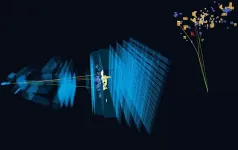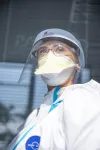(Press-News.org) The vast reservoir of carbon that is stored in soils probably is more sensitive to destabilization from climate change than has previously been assumed, according to a new study by researchers at WHOI and other institutions.
The study found that the biospheric carbon turnover within river basins is vulnerable to future temperature and precipitation perturbations from a changing climate.
Although many earlier, and fairly localized, studies have hinted at soil organic carbon sensitivity to climate change, the new research sampled 36 rivers from around the globe and provides evidence of sensitivity at a global scale.
"The study results indicate that at the large ecosystem scale of river basins, soil carbon is sensitive to climate variability," said WHOI researcher Timothy Eglinton, co-lead author of the paper in the Proceedings of the National Academy of Sciences of the United States of America. "This means that changing climate, and particularly increasing temperature and an invigorated hydrological cycle, may have a positive feedback in terms of returning carbon to the atmosphere from previously stabilized pools of carbon in soils."
The public is generally aware that climate change can potentially destabilize and release permafrost carbon into the atmosphere and exacerbate global warming. But the study shows that this is true for the entire soil carbon reservoir, said WHOI researcher Valier Galy, the other co-lead author of the study.
The soil carbon reservoir is a key component in keeping the atmosphere in check in terms of how much carbon dioxide is in the air. The amount of carbon stored in terrestrial vegetation and soils is three times more than how much the atmosphere holds, and it consumes more than a third of the anthropogenic carbon that is emitted to the atmosphere.
To determine the sensitivity of terrestrial carbon to destabilization from climate change, researchers measured the radiocarbon age of some specific organic compounds from the mouths of a diverse set of rivers. Those rivers--including the Amazon, Ganges, Yangtze, Congo, Danube, and Mississippi--account for a large fraction of the global discharge of water, sediments and carbon from rivers to the oceans.
Terrestrial carbon, however, is not so simple to isolate and measure. That's because carbon in rivers comes from a variety of sources, including rocks, organic contaminants such as domestic sewage or petroleum that differ widely in their age, and vegetation. To determine what's happening within the rivers' watersheds, and to measure radiocarbon from the terrestrial biosphere, researchers focused on two groups of compounds: the waxes of plant leaves that serve a protective function for the plants' leaf surface and lignin, which is the woody "scaffolding" of land plants.
Taking these measurements showed a relationship between the age of the terrestrial carbon in the rivers and the latitude where the rivers reside, researchers found. That latitudinal relationship prompted researchers to infer that climate must be a key control in the age of the carbon that is exported from the terrestrial biosphere to these rivers, and that temperature and precipitation are primary controls on the age of that carbon.
"Why this study is powerful is because this large number of rivers, the wide coverage, and the wide range of catchment properties give a very clear picture of what's happening at the global scale," said Galy. "You could imagine that by going after lots of rivers, we would have ended up with a very complicated story. However, as we kept adding new river systems to the study, the story was fairly consistent."
"In many respects, Earth scientists see rivers as being a source signal that is sent to sedimentary records that we can interpret," said Eglinton. "By going to sedimentary records, we have the opportunity to look at how the terrestrial biosphere has responded to climate variability in the past. In addition, by monitoring rivers in the present day, we can also use them as sentinels in order to assess how these watersheds may be changing."
INFORMATION:
About Woods Hole Oceanographic Institution
The Woods Hole Oceanographic Institution (WHOI) is a private, non-profit organization on Cape Cod, Massachusetts, dedicated to marine research, engineering, and higher education. Established in 1930, its primary mission is to understand the ocean and its interaction with the Earth as a whole, and to communicate an understanding of the ocean's role in the changing global environment. WHOI's pioneering discoveries stem from an ideal combination of science and engineering--one that has made it one of the most trusted and technically advanced leaders in basic and applied ocean research and exploration anywhere. WHOI is known for its multidisciplinary approach, superior ship operations, and unparalleled deep-sea robotics capabilities. We play a leading role in ocean observation and operate the most extensive suite of data-gathering platforms in the world. Top scientists, engineers, and students collaborate on more than 800 concurrent projects worldwide--both above and below the waves--pushing the boundaries of knowledge and possibility. For more information, please visit http://www.whoi.edu
Additional authors and institutions:
Timothy I. Eglinton: a,b,1
Valier V. Galy: b,1
Jordon D. Hemingway: b,c
Xiaojuan Feng: a,b,d
Hongyan Bao: e,3
Thomas M. Blattmann: a,4
Angela F. Dickens: b,5
Hannah Gies: a
Liviu Giosan: f
Negar Haghipour: a,g
Pengfei Hou: h
Maarten Lupker: a
Cameron P. McIntyre: a,g,6
Daniel B. Montluçon: a
Bernhard Peucker-Ehrenbrink: b
Camilo Ponton: f,7
Enno Schefuß: b,i,
Melissa S. Schwab: a
Britta M. Voss: b,8
Lukas Wacker: g
Ying Wu: e
Meixun Zhao:
a: Department of Earth Sciences, ETH Zurich, 8092, Switzerland
b: Department of Marine Chemistry and Geochemistry, Woods Hole Oceanographic Institution, Woods Hole, MA 02543
c: Department of Earth and Planetary Sciences, Harvard University, Cambridge, MA 02138
d: State Key Laboratory of Vegetation and Environmental Change, Institute of Botany, Chinese Academy of Sciences, Beijing 100093, China
e: State Key Laboratory of Estuarine and Coastal Research, East China Normal University, Shanghai 200062, China
f: Department of Geology and Geophysics, Woods Hole Oceanographic Institution, Woods Hole, MA 02543
g: Laboratory for Ion Beam Physics, Department of Physics, ETH Zurich, 8093 Zurich, Switzerland
h: Frontiers Science Center for Deep Ocean Multispheres and Earth System, Key Laboratory of Marine Chemistry Theory and Technology, Ministry of Education, Ocean University China, Qingdao 266100, China
i: Center for Marine Environmental Sciences, University of Bremen, Bremen 28359, Germany
1: T.I.E. and V.V.G. contributed equally to this work
As the pandemic's economic effects drive more people to enroll in Medicaid as safety-net health insurance, a new study suggests that the program's dental coverage can improve their oral health in ways that help them seek a new job or do better at the one they have.
The study focuses on the impact of dental coverage offered through Michigan's Medicaid expansion, called the Healthy Michigan Plan. The researchers, from the University of Michigan, used a survey and interviews to assess the impact of this coverage on the health and lives of low-income people who enrolled.
In all, 60% of the 4,090 enrollees surveyed for the new study had visited a dentist at least once since enrolling ...
Daily national surveys by Carnegie Mellon University show that while COVID-19 vaccine uptake has increased, the proportion of vaccine-hesitant adults has remained unchanged. The concerns about a side effect remain high, especially among females, Black adults and those with an eligible health condition.
The Delphi Research Group at CMU in partnership with Facebook released its latest survey findings. The analyses show that vaccine hesitancy persists and point to potential tactics to combat it.
"Prior research by the CDC has found that Black and Hispanic adults are the least likely to receive the annual flu vaccine each year," said Alex Reinhart, assistant teaching professor in CMU's Department of Statistics & Data Science and a member of the Delphi ...
It can be hard to resist lapsing into an exaggerated, singsong tone when you talk to a cute baby. And that's with good reason. Babies will pay more attention to baby talk than regular speech, regardless of which languages they're used to hearing, according to a study by UCLA's Language Acquisition Lab and 16 other labs around the globe.
The study found that babies who were exposed to two languages had a greater interest in infant-directed speech -- that is, an adult speaking baby talk -- than adult-directed speech. Research has already shown that monolingual babies prefer baby talk.
Some parents worry that teaching two languages could mean an infant won't learn to speak on time, but the new study shows bilingual babies are developmentally right ...
In Slovakia, in counties subject to two rounds of rapid antigen testing for SARS-CoV-2 where those who tested positive then isolated, the approach helped decrease the prevalence of positive tests by more than 50% in a week - all while primary schools and workplaces remained open. "While it was impossible to disentangle the precise contribution of control measures and mass testing," the authors said, mass testing is likely to have had a substantial effect, their modeling showed. Applying mass testing may provide a valuable tool in future containment of SARS-CoV-2 elsewhere, they say. ...
Rapid 3D microscopic imaging of fluorescent samples has gained increasing importance in numerous applications in physical and biomedical sciences. Given the limited axial range that a single 2D image can provide, 3D fluorescence imaging often requires time-consuming mechanical scanning of samples using a dense sampling grid. In addition to being slow and tedious, this approach also introduces additional light exposure on the sample, which might be toxic and cause unwanted damage, such as photo-bleaching.
By devising a new recurrent neural network, UCLA researchers have demonstrated a deep learning-enabled volumetric microscopy framework for 3D imaging of fluorescent samples. This new method only requires a few 2D images of the sample to be ...
NIMS and the Tokyo Institute of Technology have jointly discovered that the chemical compound Ca3SiO is a direct transition semiconductor, making it a potentially promising infrared LED and infrared detector component. This compound--composed of calcium, silicon and oxygen--is cheap to produce and non-toxic. Many of the existing infrared semiconductors contain toxic chemical elements, such as cadmium and tellurium. Ca3SiO may be used to develop less expensive and safer near-infrared semiconductors.
Infrared wavelengths have been used for many purposes, including optical fiber communications, photovoltaic power generation and night vision devices. Existing semiconductors ...
Imperial physicists are part of a team that has announced 'intriguing' results that potentially cannot be explained by our current laws of nature.
The LHCb Collaboration at CERN has found particles not behaving in the way they should according to the guiding theory of particle physics - the Standard Model.
The Standard Model of particle physics predicts that particles called beauty quarks, which are measured in the LHCb experiment, should decay into either muons or electrons in equal measure. However, the new result suggests that this may not be happening, which could point to the existence of new particles or interactions not explained by the Standard Model.
Physicists from Imperial College ...
BEER-SHEVA, Israel, March 23, 2021 - Ben-Gurion University of the Negev (BGU) researchers have found that the Pfizer Coronavirus vaccine is moderately less effective against the South African variant, but still neutralizes the British variant and the original SARS-CoV-2 strain.
Their research was just published in the prestigious journal Cell Host and Microbe.
"Our findings show that future variants could necessitate a modified vaccine as the virus mutates to increase its infectivity," says principal investigator Dr. Ran Taube of the Shraga Segal Department of Microbiology, Immunology and Genetics in the Faculty of Health Sciences.
The BGU scientists evaluated the vaccine effectiveness ...
Metallic microstructures are the key components in almost every current or emerging technology. For example, with the next wireless communication standard (6G) being established, the need for advanced components and especially antennas is unbroken. The drive to yet higher frequencies and deeper integration goes hand in hand with miniaturization and fabrication technologies with on-chip capability. Via direct laser writing - an additive manufacturing technology that offers sub-micron precision and feature sizes - highly sophisticated and integrated components come into reach. One big advantage of direct laser writing is that it is not limited to the fabrication of planar structures but enables almost arbitrary 3D microstructures. This ...
A study has found that a new 'care bundle' can reduce the incidence of facial pressure injuries in frontline COVID-19 healthcare workers caused by the prolonged wearing of Personal Protective Equipment (PPE).
The study, led by researchers from RCSI University of Medicine and Health Sciences Skin Wounds and Trauma (SWaT) Research Centre, is published in the current edition of the Journal of Wound Care.
The research took place over a two-month period amongst healthcare workers in a large acute hospital in Ireland. In the study, approximately 300 frontline staff were provided with a care ...




